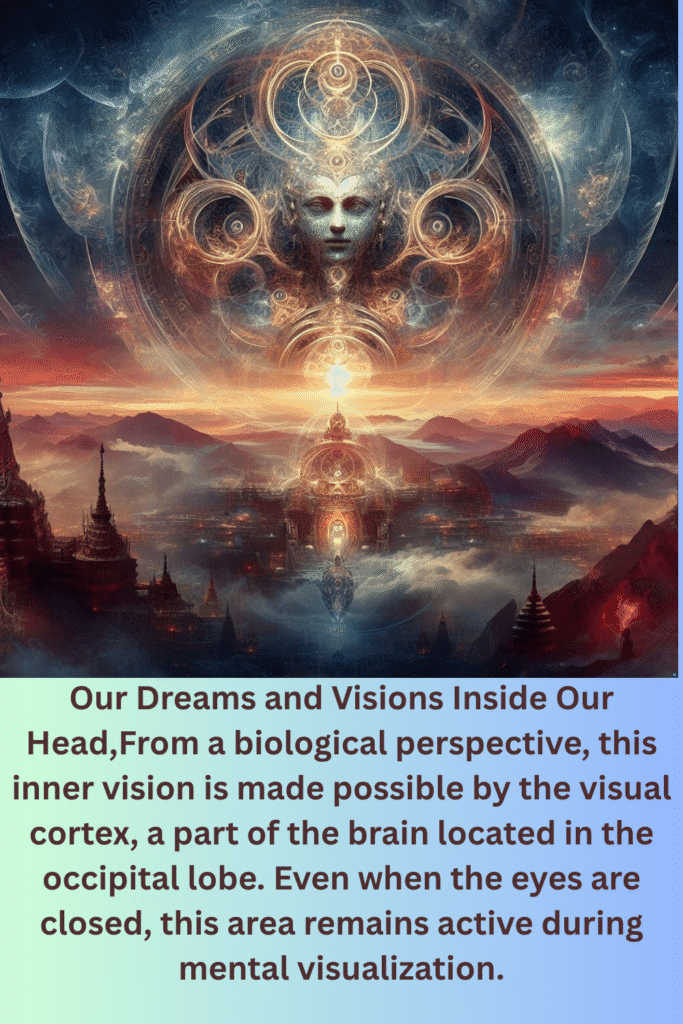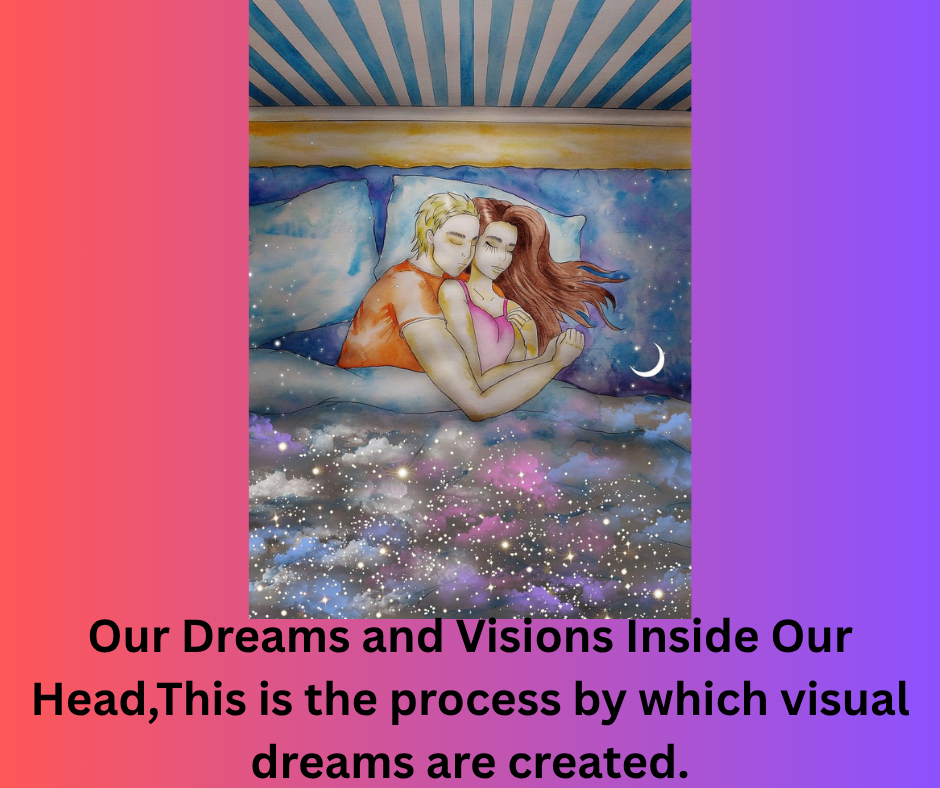Our Dreams and Visions Inside Our Head,Have you ever woken up from a dream so vivid that it felt real, even though your eyes were closed the entire time? Or maybe you’ve pictured something so clearly in your mind—like an upcoming event or a memory from the past—that it felt like watching a movie in your head. But how are we able to “see” dreams and visions inside our minds when there’s no actual light or visual input?
This question blends neuroscience, psychology, and biology, and the answers are both fascinating and complex. In this article, we explore the science behind mental imagery, dream visualization, and how the brain creates these vivid inner experiences.

Table of Contents
What Does It Mean to “See” Inside Our Head?
When we talk about “seeing” dreams or inner visions, we’re referring to visual mental imagery—the ability to create pictures in the mind without external visual input. This happens during both dreaming (especially during REM sleep) and conscious imagination.
Our Dreams and Visions Inside Our Head,From a biological perspective, this inner vision is made possible by the visual cortex, a part of the brain located in the occipital lobe. Even when the eyes are closed, this area remains active during mental visualization.
The Brain’s Visual System: Key to Mental Imagery
The human brain processes visual information through a complex network of regions collectively known as the visual system. The main components involved in “seeing” internally include:
1. The Visual Cortex (Occipital Lobe)
- Located at the back of the brain.
- The processing of visual information from the eyes falls under this responsibility.
- Involved in both real vision and imagined vision, like dreams or mental images.
2. The Prefrontal Cortex
- Manages complex thoughts, decision-making, and imagination.
- Helps initiate and organize dream content and mental visuals.
3. The Thalamus
- Acts as a relay station for sensory information.
- During sleep, it filters out external stimuli but allows internal sensory activity (like dreams) to reach the cortex.
These parts of the brain collaborate to recreate visual experiences in our minds—whether they’re real, remembered, or imagined.
How Do We “See” Dreams While Sleeping?
Our brain is very active when we sleep in REM (Rapid Eye Movement) sleep. The brain acts as though it is awake in many ways, even though the body is at rest and the eyes are closed. Our Dreams and Visions Inside Our Head,This is the process by which visual dreams are created.
1. Activation of the Visual Cortex during REM
- •Brain scans reveal that during REM sleep, the visual cortex is highly active. By creating images without the use of light or other external stimuli, the brain “simulates” hearing..
2. Reduced Prefrontal Cortex Activity
- The part of the brain that regulates logic and critical thinking becomes less active.
- This is why dreams can be irrational, symbolic, or impossible in real life.
3. Memory and Emotion Centers Take Over
- The hippocampus and amygdala, which handle memory and emotion, heavily influence dream content.
- As memories and emotions get processed, the brain “visualizes” them through the visual cortex, creating story-like dreams.
This entire process is so immersive that our minds believe we’re actually experiencing these visuals—even though it’s all happening inside the brain.
How Are Daydreams and Mental Images Created?
Even when we are awake, the brain has the incredible ability to create lifelike images through visual imagination or mental visualization. This ability is similar to dreaming, but with more conscious control.
Here’s how it works:
1. Top-Down Processing
Mental images use top-down processing, whereas real vision uses bottom-up processing, where light enters the eyes and travels to the brain.

•The process is initiated internally by the brain, bypassing the eyes, by activating the visual cortex.
2. Reconstructing Past Visual Experiences
- The brain draws from memories, learned visual patterns, and imagination to recreate scenes.
- That’s why we can visualize a friend’s face, a sunset, or even fictional places we’ve never seen.
3. Creative Visualization and Prediction
The parietal lobe and prefrontal cortex aid in outcome prediction, creative idea generation, and simulation of future events.
• Mental rehearsal is a common tool used by athletes and performers to envision success.
Why Do Mental Images Feel So Real?
Mental imagery can sometimes be so vivid that it’s difficult to tell the difference between real and imagined experiences. Our Dreams and Visions Inside Our Head,This phenomenon occurs because:
Real and imagined vision are supported by the same neural circuits.
• Strong emotional triggers, like joy, fear, or trauma, can intensify dreams and mental images.
• On a neurological level, the brain processes imagined events in a similar way to actual ones.
In fact, fMRI studies show that imagining an object activates nearly the same brain areas as actually seeing it. This overlap is why some people can feel emotional or even physical responses just from imagining a situation.
The Science of Lucid Dreaming: Awareness inside the Visual World
A person experiencing a lucid dream becomes aware that they are dreaming and sometimes has control over the dream’s plot. This experience further illustrates how the brain can consciously regulate internal images.
Biologically, this happens when:
Self-awareness is made possible by the reactivation of the prefrontal cortex during REM sleep.
•As the dreamer engages in both director and observer roles, the brain keeps producing visual content. Lucid dreaming highlights how powerful the brain’s internal visualization system truly is.
What about People Who Can’t Visualize? (Aphantasia)
Some people have a condition called aphantasia, where they are unable to form mental images. Our Dreams and Visions Inside Our Head,Despite understanding what something looks like, they can’t “see” it in their mind.
Research suggests this may be due to:
- Reduced connectivity between the prefrontal cortex and the visual cortex.
- Low activation of the visual cortex during imagination tasks.
Aphantasia shows how the ability to “see” inside our head relies on specific brain regions working together.
Conclusion
The ability to “see” dreams and visions in our minds is one of the most astonishing biological feats of the human brain. Our Dreams and Visions Inside Our Head,Whether during REM sleep or conscious imagination, our brains use the same systems that process external vision to create inner movies, mental pictures, and dream experiences.
This internal visualization system is essential for:
- Memory recall
- Emotional healing
- Creative thinking
- Problem solving
So, the next time you visualize a goal, recall a cherished memory, or wake from a vivid dream, remember—you’re witnessing the power of your brain’s inner eye in action.